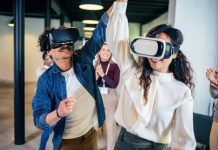
Much of the current conversation about the multi-generational workforce has centered on recruitment and, most significantly, on attracting the youngest group, Gen Z. Born in 1997, they’re just starting their careers but are expected to make up nearly a third of the workforce by next year. Hiring Is essential, of course. But, once they’re hired, it will be a challenge to retain Gen Z. It’s a challenge that has also become more difficult across all generations. A recent Gallup survey revealed that over half (51 percent) of U.S. employees seek a new job.
Every leader knows learning and development (L&D) is critical to retention. But L&D isn’t only about retention. It’s as much about growing and developing your entire workforce and investing in all the people who will help your organization succeed.
So, how can you maximize the impact of your L&D strategy to appeal to individuals in an increasingly diverse generational workforce while meeting the organization’s broader strategic goals? In large part, the answer lies in addressing two generational disparities in two areas:
- The differences in learning styles among different generations
- The differences in leadership styles and company culture that empower and resonate with different generations
Generational learning styles and preferences
L&D today has the daunting task of appealing to and connecting with employees spanning at least four decades — even if they just hope to reach the oldest Gen Z employee (now 27 years old) and the youngest baby boomer (now 60 years old). L&D leaders can foster greater career satisfaction and performance in a generationally diverse workforce through Career Conversations — if these discussions implement the right management style and communication approach to meet various personalities and work styles.
So, it should come as no surprise that each generation has unique preferences toward learning. Gen Z’s life has been shaped since 9/11 and lifelong access to the internet. The Vietnam War, the Civil Rights movement, and Watergate shaped boomers.
Baby boomers favor experience-based learning. They’ve usually built their careers and skills through hands-on learning and value L&D opportunities that let them apply their knowledge in real-world situations. In addition, Boomers are more likely to prefer collaborative and team-oriented learning and mentorship programs.
Gen X favors self-directed learning. They prefer learning opportunities, such as online courses and self-study resources, that let them control their pace and direction. They’re also more likely to value L&D opportunities that can be accessed outside of traditional office hours and learning content that is highly practical and job-related.
Millennials lean toward technology-driven learning. They’re digital natives who appreciate e-learning platforms, mobile apps, and online resources. They’ve grown up learning through interactive and engaging content. They value ongoing feedback and recognition and focus on personal growth, not just job-related skills.
Generation Z wants hands-on learning. They prefer experiential learning, such as internships, simulations, and real-world projects. They also value social learning in collaborative environments, often leveraging social media and online forums (a modern spin on what Boomers appreciate). On the other hand, mirroring both Millenials and Gen X, Gen Z appreciates tailored learning experiences that align with their individual interests and career ambitions.
Empower the different generations by understanding what resonates with them
Just as each generation in today’s workforce prefers a different style of learning, each also has its own set of values and expectations when it comes to interactions with managers and leaders and company culture. L&D leaders who address these differences in the design of their learning programs will empower their entire workforce and make employees in each generation feel respected and heard. These are critical catalysts for greater engagement, performance, and retention.
Baby Boomers are known for their loyalty and work ethic. They value job security and personal interaction with managers and team leaders. They prefer face-to-face communication.
Gen X is characterized by independence and resourcefulness. They also place a high value on work-life balance and aren’t as driven by job security. This is one reason that they appreciate flexibility in their jobs and training.
Millennials are tech-savvy and prioritize purpose-driven work. They prefer regular feedback and will likely make career decisions based on a company’s commitment to social responsibility and other non-traditional business drivers.
Gen Z are digital natives who value diversity, inclusion, and authenticity. They are also more likely than other generations to prioritize mental health, be kinder, and seek out employers who offer personal support.
The best way to empower employees from different generations is through personalized learning, support, and feedback catering to their preferences and needs. Here’s how you can do that:
- Conduct a needs assessment. Start by understanding the specific learning preferences and needs of your workforce.
- Use technology. Leverage e-learning platforms and learning management systems that support personalized learning pathways and deliver a range of content types, such as videos, articles, and online courses.
- Offer a mix of learning options. To create a well-rounded learning ecosystem, consider combining instructor-led training, online courses, microlearning modules, and social learning opportunities.
- Encourage peer-to-peer learning. Implement peer-to-peer learning initiatives to foster a culture of collaboration and knowledge sharing. Encourage employees from different generations to share their expertise and experiences through mentoring programs, cross-functional projects, or informal lunch-and-learn sessions. This approach not only enhances learning but also fosters intergenerational relationships and collaboration.
- Provide ongoing support and feedback. Establish a feedback loop between employees and their managers to ensure personalized learning experiences are practical and aligned with career goals.
Summing Up
Employees increasingly view a vibrant L&D culture as a key element of a great workplace. However, one study that reached that conclusion also found that nearly half of all employees are pursuing learning opportunities on their own, outside of training at work. Does that mean employees will leave a job for one with more significant or better learning opportunities? The answer is probably.
A survey commissioned by Amazon and conducted by Workplace Intelligence found that two out of three employees were likely to leave their jobs in the next year because of a lack of skills development opportunities. On the other hand, LinkedIn Learning research reported that 94 percent of employees would stay at a company longer if it invested in their careers.
These numbers underscore the urgent need for organizations to reassess their L&D strategies and ensure that they are effectively meeting the needs of their multi-generational workforce. In a rapidly changing work environment, organizations that prioritize personalized learning experiences will foster a culture of continuous learning and position themselves as employers of choice for top talent across generations.




